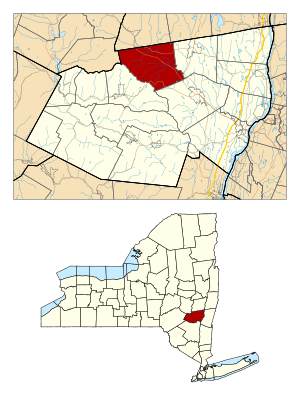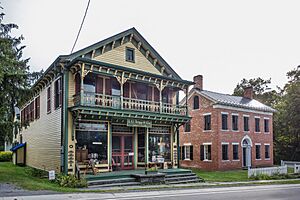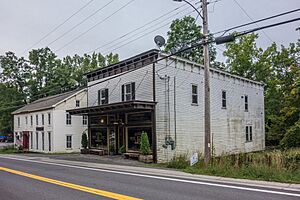Durham, New York facts for kids
Quick facts for kids
Durham, New York
|
|
|---|---|

Location in Greene County and the state of New York.
|
|
| Country | United States |
| State | New York |
| County | Greene |
| Government | |
| • Type | Town Council |
| Area | |
| • Total | 49.35 sq mi (127.83 km2) |
| • Land | 49.31 sq mi (127.72 km2) |
| • Water | 0.04 sq mi (0.11 km2) |
| Elevation | 925 ft (282 m) |
| Population
(2020)
|
|
| • Total | 2,627 |
| • Density | 53.232/sq mi (20.551/km2) |
| Time zone | UTC-5 (Eastern (EST)) |
| • Summer (DST) | UTC-4 (EDT) |
| ZIP code |
12422
|
| Area code(s) | 518 |
| FIPS code | 36-039-21204 |
| GNIS feature ID | 0978913 |
Durham is a town located in Greene County, New York, in the United States. In 2020, about 2,627 people lived here.
Contents
History of Durham
The area that is now Durham was first settled around 1755. At that time, it was part of Albany County.
The town was officially created in 1790 from a part of Coxsackie. It was first called "Town of Freehold." In 1800, Freehold became part of the new Greene County. The town's name changed to "Durham" in 1805. Many early settlers came from Connecticut and informally called it "New Durham."
Over the years, parts of Durham were used to form other towns. In 1803, parts became Cairo, Greenville, and Windham. In 1836, the western part of Durham became Conesville in Schoharie County.
The first recorded visit to the Durham area was in 1767 by Eliab Youmans. He was surveying land grants called "patents." These patents were the first official ways to divide the land for settlement.
The Maitland Patent was an important land grant. It was the first one completely within what would become Durham. This patent was for 5,000 acres and was given to Colonel Richard Maitland. It included the area known today as Oak Hill.
The first known lease for land in Durham was in 1774 to Lucas DeWitt. This suggests that people might have been living there even earlier, possibly by 1771. Oak Hill grew into a busy area with mills and homes in the early 1800s.
Three men are known for starting the first settlement in Durham: Lucas DeWitt, John Plank, and Hendrick Plank. They built their homes in a place then called DeWittsburg, which is now Oak Hill.
During the American Revolutionary War, these pioneers had to leave their homes for a while. Hendrick Plank was taken by Native Americans and died in Canada. After the war, around 1782, Lucas DeWitt and John Plank returned. Hendrick's widow also came back after remarrying. DeWitt brought a small hand mill, making him the town's first miller.
Geography of Durham
The town of Durham covers about 49.3 square miles (127.8 square kilometers). Most of this area is land, with a very small amount of water.
The northern border of Durham touches Albany County. Part of its western border is shared with Schoharie County.
Population of Durham
| Historical population | |||
|---|---|---|---|
| Census | Pop. | %± | |
| 1820 | 2,979 | — | |
| 1830 | 3,039 | 2.0% | |
| 1840 | 2,813 | −7.4% | |
| 1850 | 2,600 | −7.6% | |
| 1860 | 2,558 | −1.6% | |
| 1870 | 2,257 | −11.8% | |
| 1880 | 2,173 | −3.7% | |
| 1890 | 1,925 | −11.4% | |
| 1900 | 1,636 | −15.0% | |
| 1910 | 1,475 | −9.8% | |
| 1920 | 1,211 | −17.9% | |
| 1930 | 1,104 | −8.8% | |
| 1940 | 1,223 | 10.8% | |
| 1950 | 1,233 | 0.8% | |
| 1960 | 1,313 | 6.5% | |
| 1970 | 1,651 | 25.7% | |
| 1980 | 2,283 | 38.3% | |
| 1990 | 2,324 | 1.8% | |
| 2000 | 2,592 | 11.5% | |
| 2010 | 2,725 | 5.1% | |
| 2020 | 2,627 | −3.6% | |
| U.S. Decennial Census 2020 | |||
Durham Population in 2010
In 2010, there were 2,725 people living in Durham. These people lived in 1,152 households. About 770 of these households were families.
Most of the people in Durham (97.5%) were White. A small number were African American, Native American, or Asian. About 2.3% of the population identified as Hispanic or Latino.
About 24% of households had children under 18 living with them. Almost half of the households (49.7%) were married couples living together. About 20.4% of the people were 65 years old or older. The average age in Durham was 46 years.
Communities and Locations in Durham
Durham has several small communities and areas:
- Cornwallville — A small village south of Durham village. It is home to historic stone arch bridges.
- Durso Corner — A small village east of East Windham.
- Durham — This is the main village in the northern part of the town.
- East Durham — A small village southeast of Durham village.
- East Windham — A small village at the southern edge of the town.
- Hervey Street — A small village near the southern town line. It also has a historic stone arch bridge.
- Mount Pisgah — A high point (elevation) at the western town line.
- Oak Hill — A small village northeast of Durham village. This area was important in the town's early history.
- Sunside — A small village in the southeastern part of the town.
- South Durham — A small village in the southeastern part of the town.
- West Durham — A small village near the western town line.
Notable People from Durham
Several interesting people have connections to Durham:
- John Adams (1778–1854) — He was a U.S. congressman from New York. He taught school and practiced law in Durham.
- Brooks Atkinson (1894–1984) — A famous journalist who was a drama critic for The New York Times for 31 years.
- Dwight Baldwin (1798–1886) — A missionary who worked in Hawaii. He was raised in Durham, New York.
- Blossom Dearie (1924–2009) — A well-known jazz singer who grew up in East Durham.
- Alfred W. Newman (1834–1898) — He served on the Wisconsin Supreme Court.
See also
 In Spanish: Durham (Nueva York) para niños
In Spanish: Durham (Nueva York) para niños



